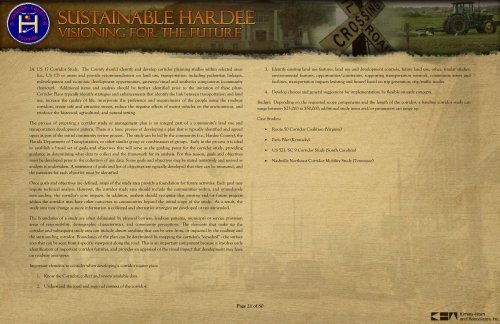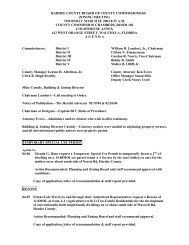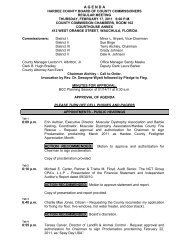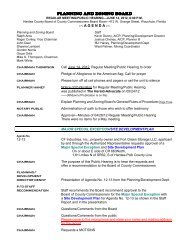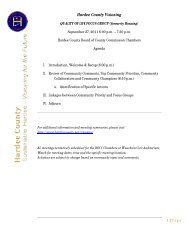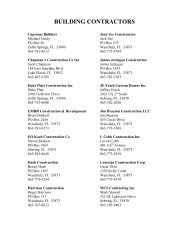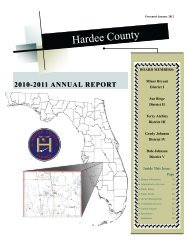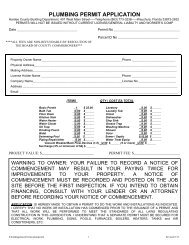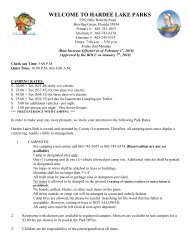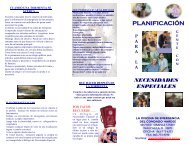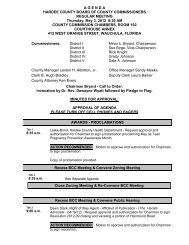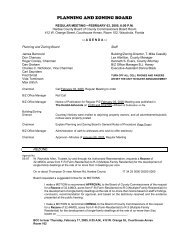FINAL Document 1/23/2013 - Hardee County
FINAL Document 1/23/2013 - Hardee County
FINAL Document 1/23/2013 - Hardee County
You also want an ePaper? Increase the reach of your titles
YUMPU automatically turns print PDFs into web optimized ePapers that Google loves.
24. US 17 Corridor Study. The <strong>County</strong> should identify and develop corridor planning studies within selected areas<br />
(i.e., US 17) to assess and provide recommendations on land use, transportation including pedestrian linkages,<br />
redevelopment and economic development opportunities, gateways/visual and aesthetics components (community<br />
character). Additional items and analysis should be further identified prior to the initiation of these plans.<br />
Corridor Plans typically identify strategies and enhancements that identify the link between transportation and land<br />
use, increase the quality of life, incorporate the preference and requirements of the people using the roadway<br />
corridors, create safe and attractive streets, reduce the negative effects of motor vehicles on the environment, and<br />
reinforce the historical, agricultural, and natural setting.<br />
The process of preparing a corridor study or management plan is an integral part of a community’s land use and<br />
transportation development pattern. There is a basic process of developing a plan that is typically identified and agreed<br />
upon as part of the initial community review process. The study can be led by the community (i.e., <strong>Hardee</strong> <strong>County</strong>), the<br />
Florida Department of Transportation, or other similar group or combination of groups. Early in the process it is ideal<br />
to establish a broad set of goals and objectives that will serve as the guiding point for the corridor study, providing<br />
guidance in determining what data to collect and the framework for its analysis. For this reason, goals and objectives<br />
must be developed prior to the collection of any data. Some goals and objectives may be stated tentatively and revised as<br />
analysis is undertaken. A statement of goals and list of objectives are typically developed that they can be measured, and<br />
the measures for each objective must be identified.<br />
3. Identify existing land use features, land use and development controls, future land use, other, similar studies,<br />
environmental features, opportunities/constraints, supporting transportation network, community assets and<br />
facilities, transportation impacts (existing and future) based on trip generation, trip/traffic modes.<br />
4. Develop choices and general suggestions for implementation; be flexible on early concepts.<br />
Budget: Depending on the requested scope components and the length of the corridor, a baseline corridor study can<br />
range between $25,000 to $50,000; additional study items and/or parameters can range up.<br />
Case Studies:<br />
<br />
<br />
<br />
<br />
Route 50 Corridor Coalition (Virginia)<br />
Paris Pike (Kentucky)<br />
US 521/SC 9 Corridor Study (South Carolina)<br />
Nashville Northeast Corridor Mobility Study (Tennessee)<br />
Once goals and objectives are defined, maps of the study area provide a foundation for future activities. Each goal may<br />
require technical analysis. However, the corridor study area should include the communities within, and immediately<br />
surrounding, the corridor's core impacts. In addition, analysis should recognize that existing and/or future projects<br />
within the corridor may have other outcomes to communities beyond the initial scope of the study. As a result, the<br />
study area may change as more information is collected and alternative strategies are developed or recommended.<br />
The boundaries of a study are often delineated by physical barriers, land-use patterns, municipal or service provision<br />
areas of responsibility, demographic characteristics, and community perceptions. The elements that make up the<br />
corridor and subsequent study area can include almost anything that can be seen from, or impacted by the roadway and<br />
the surrounding corridor. Boundaries of the plan can be determined by mapping the corridor's "viewshed" - the surface<br />
area that can be seen from a specific viewpoint along the road. This is an important component because it involves early<br />
identification of important corridor features, and provides an appraisal of the visual impact that development may have<br />
on roadway area views.<br />
Important elements to consider when developing a corridor master plan:<br />
1. Know the Corridor; collect and review available data.<br />
2. Understand the local and regional context of the corridor.<br />
Page 21 of 80


